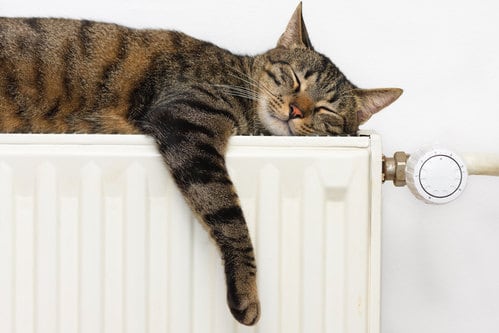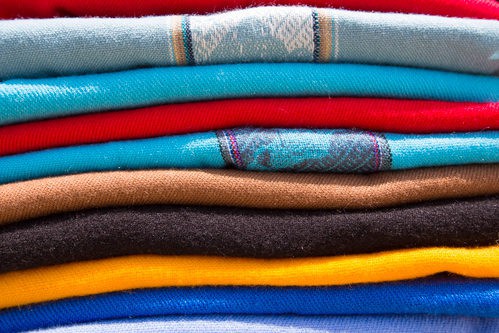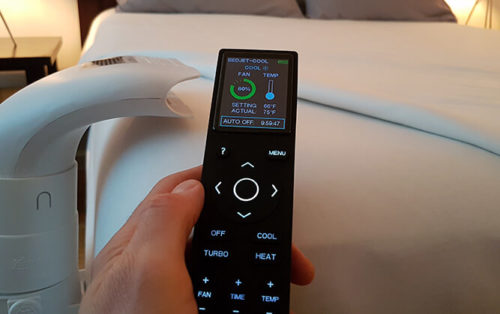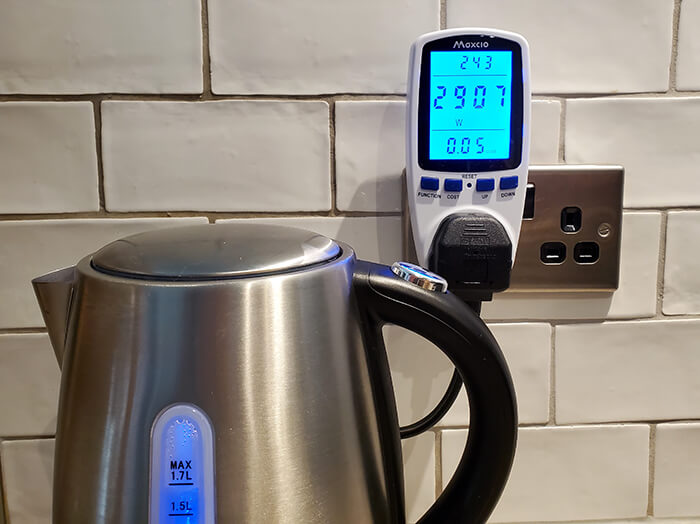
If you’re a natural-born shiverer in the bleak midwinter, the good news is that it’s much easier to warm your bed at night than it is to cool it in the summer.
For starters, your own body is a natural radiator that constantly generates warmth. While that can be a problem in warm weather, it’s a key part of the solution when the outside world freezes over.
In theory, if you have the right layers to trap some of the heat your body emits, you can keep your bed warm enough to sleep just by being there, and by being you.
However, it takes time to warm your bed that way, and nobody likes climbing between icy sheets when they’re supposed to be relaxing at the end of a long day. So if you live in a particularly cold area, it might help to use a bed heating system, as well as the right winter bedding.
Let’s take a look at some options you have for warming your bed and bedroom. Some are free, some cost money, and others just require some adjustments to the way you have the bedroom set up.
1. Heat your bedroom, not the whole house
It’s inefficient and potentially expensive to heat your entire home all night long. So on the coldest of nights, it might be better to just heat the bedroom and shut the door to keep the warmth in.
I also find it helps to put down a draft excluder, or any material you have to hand, at the base of the door if there’s a big gap.

2. Use flannel bedsheets in the winter
Flannel is a great choice of material for bedsheets in the winter. Flannel is cotton that’s been brushed to make it fluffy, rather than smooth like normal cotton sheets.
All that extra fluffiness means more air is trapped, which makes it a better insulator.
3. Create layers of top sheets and blankets
Rather than just using one thick blanket, comforter, or duvet, create layers instead. The idea is to create layers of insulation and trap air (which is a poor conductor of heat).
Layers also work well because you can remove them if you get too warm in the night. Try alternating between thinner and thicker layers to maximize the insulation effect.
If you don’t have the money to pay for expensive bed heating systems or luxury bedding, adding layers of any material can help enormously.
4. Choose a warmer duvet filling
If you’d prefer not to use materials derived from animals in the bedroom, synthetic fibers such as polyester, microfiber, or hollow fiber are good choices for warm material. Fortunately, they are all relatively inexpensive fillers and you can get high tog value (see below) duvets using these materials for a reasonable price.
Personally, I try to avoid synthetic materials in the summer because they usually feel too warm for my liking. But in the winter, I use a 13.5 tog hollow fiber duvet, and on the coldest of nights put a minky throw over the top for good measure. Not a lot of air flows through that lot, but it keeps us toasty!
If you don’t mind using animal products, a warm filling for duvets/comforters is goose or duck down. Another effective filler is wool, which traps air effectively, while still being more breathable than synthetic fillings.
What are tog values?
A “tog” is a unit used to measure the thermal resistance of a fabric, essentially indicating its insulating properties. The higher the tog value, the warmer the bedding.
Here’s a general rule of thumb for selecting tog values based on the season:
- Summer: 3.5 to 7.5 tog
- Spring and autumn: 7.5 to 10.5 tog
- Cold winters: 13.5 to 15 tog
Remember, these are just guidelines. Depending on individual preferences and specific climatic conditions, you might prefer slightly different tog values.

5. Choose warmer blanket materials
If you’re looking for a winter blanket, wool is one of the warmest natural materials you can choose, thanks to its crimped fibers that form insulating air pockets. You could also try fleece, which is a synthetic alternative that’s designed to emulate wool’s excellent insulating qualities.
Sheep’s wool is the most widely available type, but within this category, there are several luxurious varieties. Merino, Cashmere, Alpaca, Yak, or rare Qiviut all offer an upgrade to sheep’s wool, with a soft and warm feel.
Just be prepared for a bit of a shock when you see the price tag of a Merino wool blanket that’s big enough for a king-size bed!

6. Use heated bedding
Although it’s possible to warm your bed using just your own body heat and bedding, for some people it still might not be enough. If you dread getting into a cold bed every night, perhaps it’s time to warm it up before you transition from the cozy sofa to the bedroom.
The main choices of heated bedding are heated mattress pads or electric blankets. Mattress pads have the benefit of heating from underneath you, so warm the bed more efficiently.
However, electric blankets might suit some people better. They are a good choice if you don’t want wires beneath you, or find you get too hot when the heat is trapped between the bed and your body.
Personally, I use a heated blanket because my electricity bill is high enough these days without wasting even more on heat that just rises straight off the bed into the air!
7. Blow some warm air between the sheets
An effective alternative to heated bedding is a climate control system called the BedJet. My partner and I used one for several years, and were big fans.
It works by warming air over a ceramic stone in a separate unit and then blowing that warm air between your sheets and over your body.
It’s fast, effective, and has a wide range of temperature settings and features that allow you to warm your bed to the exact temperature you enjoy.

8. Wear warm pajamas and maybe socks too
Continuing with the theme of creating insulation for your body heat, try wearing some warm pajamas, perhaps from flannel if you like the feel of that. They also make getting out of bed in the night a slightly less shivery experience.
On extremely cold nights, I’ll wear socks in bed too as I’m very tall and there’s nothing worse at night than waking up with cold feet because they found their way out the end of the duvet.
9. Cuddle up to a hot water bottle
Another way to introduce an extra source of warmth is with a simple hot water bottle.
Fill it with hot water (not boiling though), and place it in your bed before you get in. You can then cuddle up to it, or use it to keep your feet warmer for the first half of the night.
If you’re tall like me, you might prefer a long hot water bottle rather than the standard shape. I didn’t even know they existed until my partner bought me one for Christmas. It’s great to have the whole length of my back warmed by it on the nights we sleep apart.
Remember not to combine a hot water bottle and heated bedding though. Also check the quality of the design and screw top before buying one to make sure you don’t have any leaks at night.
10. Snuggle up to your partner (or your dog)
Finally, one you probably already know if you sleep with a partner. Snuggling up together is a great way to insulate your combined body heat, ensuring you keep even more of it from escaping.
After considering some of the comments from readers below, the dog idea has finally made it onto the list. Speaking from experience, it’s amazing how much heat even relatively small dogs emit. They are furry hot water bottles with legs!
Just don’t expect them to keep you cool in the summer once they’ve gotten used to the luxury of sleeping in the human bed…
What’s the ideal bedroom temperature?
Experience has taught me that I personally prefer a slightly cooler bedroom temperature – as long as I don’t actually feel cold under the covers. But why is that?
A drop in air temperature at night is one of the key signals our internal body clock uses to know that it’s nearing bedtime. Overheating your bedroom could interfere with this natural process and potentially affect sleep quality.
It’s worth noting that everyone’s comfort level varies based on factors like age, health, and personal preference. However, if you’re uncertain about the ideal setting for your bedroom thermostat, the Cleveland Clinic suggests a bedroom temperature between 60 and 67 degrees Fahrenheit (15.5 and 19.5 degrees Celsius) for adults.
While it’s tempting to keep your bed cozy and warm, especially when your home is blanketed in snow, excessive warmth might have the opposite effect on your sleep than intended.
That said, it’s equally important not to feel too cold, as it’s hard to sleep if you’re shivering in bed. Perhaps the principle of ‘everything in moderation’ applies to the bedroom temperature too.
As researchers in Japan wrote in 2012, it’s all about not sleeping in extreme temperatures, whether that’s too hot or too cold. As they put it:
The thermal environment is a key determinant of sleep because thermoregulation is strongly linked to the mechanism regulating sleep. Excessively high or low ambient temperature may affect sleep even in healthy humans without insomnia.
Kazue Okamoto-Mizuno & Koh Mizuno
Using a power meter to work out the most cost-effective way to heat my bedroom
I don’t know how things are where you live, but here in the UK where I’m currently writing from, the cost of electricity is painful right now. We’re billed 45 pence per kilowatt hour during the daytime and 22 at night.
I recently moved house and decided to use a power meter to see which appliances were costing more, and also to test different settings on white goods like the washing machine.
I got quite into my testing, and calculated how much every single setting would cost me when used twice a week for a month. Unsurprisingly, not using the drying settings, and opting for shorter washes saves a fair bit of money over the month.
I also tested different heating methods for the bedroom at night to see which would be the most cost effective.
It turned out that it costs me around five pence to boil enough water in the kettle for a cup of bedtime tea and to half fill a hot water bottle along with cold water (I don’t want any scalding surprises!).

More importantly, I discovered it was cheaper to use a heated mattress pad all night rather than my gas central heating bedroom radiator or a small electric heater.
Just to clarify, I didn’t measure the central heating with the power meter. I had to base that on fresh meter readings entered into my energy supplier account to see what I had used at night.
It was good to have some facts that were specific to my home that I could work with, and reassuring to know that we were heating our bedroom at night in the most cost-effective way we could.
If you don’t have a power meter, it’s worth considering buying or borrowing one for a week to do some testing. You might be surprised by what you find.
Please note that I am not qualified to give financial advice based on power usage – I just wanted to share what I’ve personally found helpful.
Your ideas
Which techniques do you use to keep warm throughout those long winter nights? Let me know in the comments below!





Useful information. Every time I visit your website I find exactly what I was looking for. And it is very helpful for me every time when I want to buy things. Thank you.
You’re welcome Mitu! Thanks for the positive feedback too – it really means a lot to me:-)
Regards
Ethan
Helpful ideas and I will definitely try them.
Thank you for explaining nicely.
Helpful ideas, and I will definitely try them. I always wear pajamas, which is a good idea to keep warm.
Hi Mitu
Thanks, I’m glad to hear there were helpful ideas for you here. Pajamas do work well – they are a tried and trusted way to add warmth!
Regards
Ethan
For the harshest winter, we usually use electric bedding. We used it for the first time when we were on vacation in Korea, and we brought some back home.
Hi Moshells
Heated bedding is definitely a good way to cope with harsher winters.
Regards
Ethan
I’ve successfully used an iron to warm the sheets before getting in bed.
Hi Sandy
Thanks for the suggestion – I quite like that one!
Regards
Ethan
I truly appreciated this article and all the comments afterward. I live where it’s hot in the summer, mild in the winter, but as my bedroom is not heated, I get quite chilly. I use flannel sheets and a pile of quilts, blankets, and throws, but I rather dislike all the weight. I will try some of the tips given here. I need to find something to keep on my head, as I can’t stand my head to be cold. In winter, my bedroom temperature hovers around 61 degrees and in the summer it hovers around 81 degrees. For several weeks in summer, I turn on the ceiling fan and sleep with nothing on top of me! It feels odd and takes me a while to get used to it. By the way, I used to say that I slept well in hotels, but I don’t anymore. This is because of the duvets. It’s usually too hot with the duvet and too cold without it. Sometimes you can get an extra blanket from housekeeping.
Hi Jillian
I’m glad the article was helpful for you. I have had a similar experience in cold weather before where you really feel it on your face, and don’t want to pile anything over your head obviously. I had some success putting large pillows propped up either side of my pillow and one between the back of my head and the headboard one particularly cold winter. I think it just helped reduce any draft, and insulate my head a bit better. It also didn’t cost anything as I already had some extra pillows, so if you do too, it’s one to try maybe.
Regards
Ethan
Microwaved Lava Buns stays warm all night, and can be moved to where the need is greatest.
Thanks for sharing this idea Denne. I think there are a range of microwavable soft products that can be used in bed. So even if people can’t get Lava Buns where they are, it’s worth seeing what else is available that does a similar job.
Regards
Ethan
There is a fabric that is made to use in outer wear, sleeping bags, pot holders, etc. Many different names-Thermal Fleece, Pellon Insul-Fleece, Insul Brite, Therma Flec. It has a “space blanket” type middle layer. It reflects your body heat back to you. I use a piece across the foot of the bed, between my flannel top sheet and my quilt. It keeps my feet warm enough that I can sleep. You could use a piece between blankets that is big enough to cover the whole bed.
Hi Deb
That’s a very good idea! I also just had an image in my head of keeping a sleeping bag at the foot of the bed for the lower limbs if you’re trying to sleep in ridiculously cold temperatures.
Regards
Ethan
I like to turn the heater on😀
I agree with your ways of being cozy and warm during the cold nights Harrie, l do the same as yourself, l place a quilt on top of my fitted sheet, then l have a 13.5 tog quilt over my flat sheet, and also a fleece blanket on top of my quilt.
Thanks for the ideas! I’m going to look for a cosy mattress topper.
Stuffed animals. If you have stuffed animals then they might help to keep you warm if you put them inside your blankets.
That’s a good tip for those with stuffed animals! All that extra padding should help, though it depends how many and how big I imagine.
Hi, no one seems to mention the benefit of an extra layer or two blankets underneath you! Or even another duvet….. Yum.
Also, two pairs of pajamas work wonders with the layers being so close to you.
Also warm the socks before putting them on for the night. Hot water bottle not good for feet, put it nearer to your core.
Also you could wear your dressing gown to bed! Very cosy.
Yes, I sleep between two duvets when it gets cold….. Also have been known to wear a hat (beanie) to bed!
Good idea it always helps me
There are some stuffed animals that are usually small but you can put them in a microwave and warm them up. I heard they really work.
I have a nephew named Ethan Green! Lol. I keep a hairdryer by my bed. When I climb in, I use it to warm it up…the temp usually lasts all night. I do the same thing when I travel internationally as well. Works well for me.
Hi Suzanne
That is a funny coincidence! I didn’t think there were so many of us:-)
Good tip as well, if a little short-lasting. But if if helps preheat the bed enough to sleep, why not?
Regards
Ethan
Hi Ethan Green!
Thanks for sharing such amazing tips! I will use those warmer blankets for my cozy winter nights. That too with cotton and wool filling inside for sure!
Keep writing informative stuff! All the best for your future posts :)
Hi Sakshi
Thanks for your kind words. I hope this next winter is warmer for you now:-)
Regards
Ethan
I researched a ton of heated blanket options and it seems all of them have their faults, some don’t turn off and you get overheated, some won’t last long or get ruined after washing, etc. Keep it simple, throw on some socks and some PJ’s and get into bed 15 minutes early and you should be good to go.
Hi there
Unfortunately, heated bedding does have a historical reputation for being problematic. I’ve reviewed several, and read hundreds of other people’s reviews. One of the problems I think is that on customer review sites like Amazon, it’s often people who have a bad experience who feel compelled to write a bad review – especially if they think it was a potentially dangerous problem – such as fault heated bedding, which naturally makes you worried if it happens. I do think it’s an area where it’s worth either spending the money to get the best one possible, and therefore ideally a safe and reliable one. Or as you quite rightly point out – just keep it simple, throw on some extra layers and let your body heat do the work!
Regards
Ethan
What if you don’t have a partner in the bed with you and don’t have any of that stuff?
Hi Kaily
Multiple layers is always an option if you have extra bedding – if not, an extra layer can be bought inexpensively if necessary.
Regards
Ethan
True
I’ve always found that partners don’t have the same thermostat anyway, and prefer a warmer or colder temperature than me when they fall asleep. Clutching each other only lasts so long, until the need for an appropriately comfortable sleep temperature wins through. Cuddle up with water bottles, PJs, brushed cotton instead. Or a dog, which is notably missing from the list. Perhaps it’s number 11 and didn’t make the cut.
My heater is broken and it’s coming up to winter. The water bottle idea is smart and cheap.
Hi Luna
Is there any way you can get it fixed, or get a new heater? Do you just have that one heater in the bedroom and no central heating system?
Regards
Ethan
Thank you for the tips! #1 is the best tip for me :)
Hi Kamille
You’re very welcome. And I agree – it’s a key point to keep in mind!
Regards
Ethan
How about before you get in bed, warm it a little bit with a hairdryer and then get in afterward and use your partner’s body to warm up.
Hi
That would work I guess, at least to take the edge of the cold feeling if it’s really bad. How about getting your partner to go to bed 10 minutes earlier on your side of the bed, and then politely ask them to move over so you can enjoy the warm feeling they just made for you? :-)
Regards
Ethan
That is true
I use the iron to heat my bedding and then get right in the bed while it is still warm
Put hand towel soaked thoroughly with water, wring it out, fold it and put it into a zipper gallon freezer bag open, place in microwave for 2-3 minutes, carefully pull out and zip closed, put in an old pillowcase and tuck into the bed to warm your toes
Hi Shirley
Thanks for your comment. This sounds like a DIY hot water bottle!
Regards
Ethan
Thanks for the tips. After freezing last winter, I’m preparing early for the next one and getting a heated pad while the prices are lower!
Hi Harry
You’re welcome, and thanks for adding your own tip there too!
Regards
Ethan
I got an organic wool mattress topper/pad and it made a big difference in my little sleep place. It feels nice and toasty within moments of getting in bed.
Hi Melissa
Thanks for sharing your thoughts – natural materials are often the best way to go.
Regard
Ethan
if you don’t have a partner, a dog or cat works too! I’ll get my dog to lay in my spot on the bed before I go to bed, so it’s warm when I go to bed.
That works!
Leave a hot water bottle under your bed sheets till you want to get in, and sometimes even put a fluffy blanket as your bottom sheet it makes me feel so much more comfortable and sleepy. I always have a great night sleep when I do these things hope it helps some of you guys have a lovely day xx
Hi Lilly
Thanks for your suggestions – both very good ones!
Regards
Ethan
I was freezing last night and searched for some suggestions for warming your bed. After reading ur suggestions I added a fleece blanket today as an extra bed sheet on top of my fitted sheet. My bed is so warm and comfy now. Made a huge difference. I so want to add a fleece blanket under my duvet and/ or to add a hot water bottle to warm my feet.
Thanks everyone!
Hi
Thanks for your comment, and I’m very happy to hear the article helped you out. Adding layers is so simple, yet so effective!
Regards
Ethan
Buy a bed tent.
Thanks Holly – that might help add an extra layer of insulation!
I have a down alternative comforter on my bed these days. This is on top of a faux shearling blanket. It’s like sleeping in a cloud. When I get too warm, I push back the down alternative comforter and find the faux shearling blanket to be “just right”.
If I feel chilled before getting into bed, I might run warm water on my feet until they’re toasty. Then put on warm socks. I might pop fleece pjs on to climb into bed. I might switch into the cooler pjs in the night, so I stash cooler ones next to my pillow.
When I lived in a very cold house in grad school, I had a featherbed mattress topper and a down comforter on my bed. In just a few minutes in that bed, I was toasty.
Hi Suz
Thanks for your comment and for sharing your tips. I like the idea of warming your feet with water before getting into bed – it’s actually the opposite of what I do in the summer to keep cool in bed! Being able to change the temperature by removing or adding layers is also great. And I like the idea of having different bed clothes available too!
Regards
Ethan